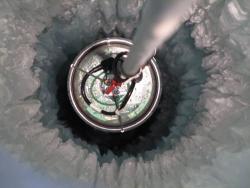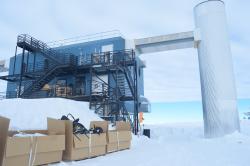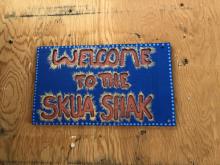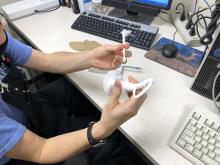Update
Now Archived! Antarctica Day Celebration event with Lesley Anderson and Dr. Jim Madsen on Monday, 4 December 2017. You can access this and other events on the PolarConnect Archives site.
What Are They Doing?

The fully built Askaryan Radio Array (ARA) project will have an effective volume 100 times larger than IceCube. The tradeoff is that it will only be capable of observing radio waves from interactions with extremely high energy neutrinos, a million times more energetic than the neutrinos produced by cosmic rays in the atmosphere. IceCube studies those lower energy atmospheric neutrinos, 100,000 per year, to learn more about neutrino properties, including their ability to transform from one type to another.
The universe is a huge and mysterious place that is largely unexplored. New technologies and creative approaches allow us to see things that aren’t directly viewable. Neutrinos will reveal new information about the Universe that can’t be recorded with optical or even more exotic telescopes that measure other types of light, like radio waves, microwaves, x-rays, and gamma rays. Many different roles and talents are needed to develop new approaches—technicians to make and operate new machines, computer experts to store and retrieve data, and scientists to define goals, identify promising projects, and guide students. IceCube and ARA are discovery instruments that will lead to a greater understanding of the cosmos and will hopefully uncover new mysteries for scientists to solve.
Where Are They?

Latest Journals

Dr. Madsen is the chair of the Physics Department at UW-River Falls and Associate Director of the IceCube Neutrino Observatory where he directs the education and outreach program. His research interests include heliophysics and astrophysics, which he has studied at his various projects in Antarctica. In addition to research, Dr. Madsen is committed to reaching a broad audience beyond the research community. He is involved in education and outreach for the IceCube project including professional development courses for teachers and science and math instruction for the UWRF Upward Bound Program. He collaborates with a number of programs and institutions in addition to PolarTREC, including the Knowles Science Teaching Foundation, UW-River Falls Upward Bound and McNair Programs, and service groups (Rotary International, Boy and Girl Scouts, university alumni associations, etc.). You can read more about Dr. Madsen's work here and here.
"Working in Antarctica is a wonderful adventure, and it is great to provide opportunities for others to have this awesome experience."

Michael DuVernois is a Senior Scientist with the Wisconsin IceCube Particle Astrophysics Center and a Research Professor with the Department of Physics at the University of Wisconsin in Madison. He is an experimental physicist working on the IceCube and ARA neutrino observatories at the South Pole. His other research interests include high-energy gamma-ray astronomy, humanitarian demining, and detector development for particle and astro-particle physics. Less technically, he has bowled on all seven continents, and is found most Austral Summers at the South Pole supervising students and technicians. He has previously flown satellite experiments in orbit and through the solar system, balloon instruments to the top of the Earth’s atmosphere, and built instrumentation for mountain-top and extended ground-based observatories.





